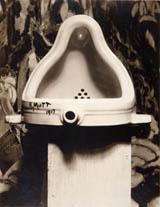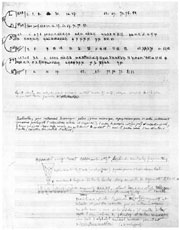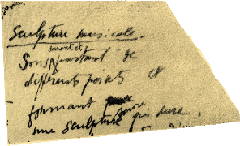[An earlier version of this article was first published in German as “Duchamp Werden,” in: CROSSINGS: Kunst zum Hören und Sehen, Vienna: Kunsthalle, 1998 (exh. cat.), p 55-61]
“They did not speak. They did not sing, they remained,
all of them, silent, almost determinedly silent; but from
the empty air they conjured music. Everything was music…”
Franz Kafka, Investigations of a Dog
John Cage first met Marcel Duchamp in the 1940s. Duchamp asked Cage to write music for his part in Hans Richter’s film “Dreams that Money Can Buy” (1946). But it took twenty more years before the two actually became close. Cage didn’t want to bother Duchamp with his friendship until he realized that Duchamp’s health was failing. Then he decided to actively seek his company. He knew that Duchamp was taking chess very seriously, and it was easy for Cage to use this pretext, so he simply asked him to teach him the game. And for the last three years of Duchamp’s life the two men and Teeny Duchamp, the bachelor’s bride, met at least once a week and played chess. (1)
It was widely believed at the time that Duchamp had stopped working. Visitors reported that his studio was empty. And it was. The studio was precisely made for that – for not making art. Duchamp had another space next door no one knew about, where he did his work. (He was putting together Étant Donnés, his last project).
Coming from Duchamp nothing was too unbelievable. Even Cage gave him credit for what he didn’t understand – for making Étant Donnés this voyeuristic show, for instance, after having renounced retinal art. Maybe he meant to contradict himself. The truth is, no one could tell for sure. Even when Cage learned that Duchamp may have taken his subject matter from Alfred Jarry, he recovered quickly from the shock. His friend must have had his reasons.
Every year Duchamp would pay a visit for a week to Salvador Dalí in Cadaquès, Spain, with Teeny and Cage in tow. Cage was mystified by the reverence Duchamp kept showing Dalí whom he himself disliked intensely like so many others. Everybody loved Duchamp, of course. The self-proclaimed genius and the self-effacing sage. The bulimic and the anorexic. Ubu Roi and Gregor Samsa. But maybe they were just two sides of the same coin. Both were busy deflating the piety of Capital – Dalí with his bloated cynicism (Breton came up with the anagram Avida Dollars to describe him best) and Duchamp with his imperceptible humor (Rrose Sélavy). The visionary paranoiac and the conceptual schizophrenic. Their delirium was paradigmatic of the age.
At bottom, Duchamp was Duchamp, an enigma to himself as to everyone else. Only he was capable of scrambling codes and genders with a strange, impersonal elegance. “Mince,” thin, slim, was Duchamp’s favorite word as “petit” or “menu” was Deleuze’s (as when he declared: “I am not sick, I simply have a petite health”). Duchamp found “infra-mince” even better as a concept. He was convinced that it took us to another space, from the second to the third dimension. Duchamp, the thin man, the hunger artist, el ombre invisible. His best performances were disappearing acts. And yet he always left traces of a sort – a signature on Fountain.
click to enlarge

Figure 1
Marcel Duchamp,
Fountain, 1917
Duchamp didn’t especially like listening to music, but its evanescence fascinated him. He kept dreaming of even more elusive sounds, sounds like the faint rustle of corduroy pants in a dance (he was always precise). Sounds for the birds. No wonder Cage got trapped.
“Duchamp placed chess above everything, and Cage was his partner.” This is what flashed in my mind when one day, out of the blue, Cage called me for a game. “You’re French,” he said, “so you must play chess.” Duchamp and me. That was in 1975, a few weeks after Cage and I first met. I cowered for a few more weeks, imagining Duchamp’s ghost breathing down my neck as I leaned over a chessboard. But Cage nudged me again and I surrendered to my destiny. We met, and played. I could hear music coming from the empty space. He narrowly won our first game.
As it turned out, he wasn’t such a formidable adversary. He was no adversary at all. It was then that he told me the Chess Master had found him a real disappointment. “Don’t you ever play to win?” Duchamp had kept asking, exasperated. Cage was a Zen Buddhist to the core: why should anyone have to win? He had already won what he wanted: spending time with Duchamp.
Cage got somewhat better at playing chess after that, trying his hand, I guess, on vague Duchamp surrogates like myself. And then there was Teeny, of course.
click to enlarge

Figure 2
Duchamp, Teeny, and Cage playing
chess in a performance, Sightssoundsystems,
a festival of art and
technology in Toronto, 1968
Actually, Cage hadn’t lost every single match with Duchamp. There was one that he definitely won, after a fashion. It happened in Toronto, in 1968. Cage had invited Duchamp and Teeny to be with him on the stage. All they had to do was play chess as usual, but the chessboard was wired and each move activated or cut off the sound coming live from several musicians (David Tudor was one of them). They played until the room emptied. Without a word said, Cage had managed to turn the chess game (Duchamp’s ostensive refusal to work) into a working performance. And the performance was a musical piece. In pataphysical terms, Cage had provided an imaginary solution to a nonexistent problem: whether life was superior to art. Playing chess that night extended life into art – or vice versa. All it took was plugging in their brains to a set of instruments, converting nerve signals into sounds. Eyes became ears, moves music. Reunion was the name of the piece. It happened to be their endgame.
Well, not quite. Less than a year later Duchamp was gone, but for Cage the game wasn’t over; it was rather like jumping into the middle of Duchamp’s disappearance act. Duchamp’s studio didn’t remain empty for long. Cage, so to speak, quickly moved in. Discreet, but focused and industrious, he gave Duchamp a piece of his own mind. From then on, it would be work as usual. There were countless traces to be picked up in Duchamp’s trail – slim cues, silent music. Cerebral circuits had to be delicately hooked on to other machines, imaginary solutions invented. Example of nonexistent problems: “What belongs to Duchamp and what belongs to me?” The problem wasn’t just crossing over – what’s identity anyway? – but making the two separate spaces work together.
In a sense Duchamp was as much alive in his death as he had been in his life. Didn’t he always want to “go underground” anyway? The imaginary solution already was at hand, and it would affect the living as well as the dead. “The effect for me of Duchamp’s work,” Cage wrote, “was to so change my way of seeing that I became in my way a Duchamp unto myself.” (2)
Cage had to see things for himself in such a way that Duchamp’s work would be kept alive through his own. The only way to celebrate Duchamp was to “recerebrate” him – a Duchampian pun Cage invented – which meant to plug Duchamp’s mind into one’s own, the way the chessboard had been plugged to the sound system. And the music would be both theirs.
This uncanny collage – this ménage à deux, moins Duchamp – remains exemplary of the kind of creative crossings that can be achieved between the various arts, but also between art and life, and art and death. Becoming someone else (Jarry-Duchamp-Cage) is a way of becoming oneself, which became the condition for Cage’s own poetics of chance and politization of aesthetics. His creative anarchism.
Very early on, in 1913, the year Cage was born, Duchamp composed a music piece en famille, Erratum Musical,
click to enlarge


Figure 3
Marcel Duchamp,
Erratum Musical, 1913
by using chance operations. The procedure was far too simple for Cage’s taste – he favored more complex operations leaving no room for intention – but it was precisely that kind of simplicity that Duchamp liked, drawing jumbled notes at random from a hat. Duchamp composed Erratum Musical with his sisters Yvonne and Magdeleine, seventy-five notes picked by chance to accompany as many syllables of the randomly chosen dictionary entry for imprimer. (3)“How is it that you used chance operations when I was just being born?” Cage asked Duchamp. This was a straight-faced question, but I don’t doubt that Cage saw in this synchronicity the start of their collaboration. He always experienced the past in the future tense – as a futur anterieur – and reclaimed this experience as his own, like everything else that concerned Duchamp. He would occasionally use chance the way Duchamp did (pulling slips of paper out of a hat) whenever he happened to be some place without his own I Ching simulation program. He always kept his “IC” in a black suitcase reminiscent of the famous “valise” in which Duchamp, ever the salt salesman (marchand du sel), kept small replicas of his art. Becoming Duchamp in the most “detailed” way.
Cage always considered music far more “detailed” than painting or visual work. In 1978, though, he was invited to make etchings at Crown Point Press. Not being an artist himself, and quite incapable of drawing, he decided to treat etchings like music – his own music – and draw into the plate with his eyes closed. But after spending two weeks every year, for fourteen years, making etchings and watercolors, they became so complex, he said, that he considered them “probably the most musical…the most detailed work, with very subtle changes in the colors and shapes.”
Duchamp didn’t especially like listening to music, and yet he made forays of his own into the world of sounds. In his writings (The Bride Stripped Bare by Her Bachelors, Even: Erratum Musical, 1913),
click to enlarge


Figure 4
Marcel Duchamp,
The Bride Stripped Bare
by Her Bachelors, Even:
Erratum Musical,1913
he conceived what Cage called after him “Duchamp’s Train,” in which each freight car would carry a different octave on the piano, so that each of the “cars” would have its own notes. Cage eventually used this idea for one of his own violin pieces. (Unlike the piano, the violin allowed him to chose sustained intervals.) For this, he had to disregard the fact that Duchamp’s train was meant for a pianist to go through the eighty-five notes of the keyboard (the standard range for a piano of that time), which the violin doesn’t have. Crossings don’t just happen between the ear and the eye, they also occur within the same medium. Actually, they always happen between the two ears – in the empty studio of the brain. As far as he was concerned, Cage always kept an eye on the eye, starting with the intricate layouts for his Mesostic texts, these acrostic-like compositions with the key letters running down the middle of the text. But the poems would also lead him onto another track. The source material would become the starting point for other experiments involving source material he didn’t even know, like German or Japanese – we could call this endo-crossing – or he would let the repetition of sounds bring him back to the world of music – exo-crossing. Innovations between the arts, therefore, are not just a matter of crossing a barrier, even the frontier between sound and form, or synthesizing the two. It is essentially rhizomatic and can proliferate in every direction. Once Cage showed me a scrap of paper that he got from Duchamp in the late 1960s.(4) Duchamp’s scribble read as follows: Sculpture Musical.
click to enlarge

Figure 5
Marcel Duchamp,
Note from the
Green Box, 1934
Sons durant et partant de différent points et formant une sculpture sonore qui dure. (“Musical Sculpture. Sounds lasting and leaving from different places and forming a sounding sculpture that lasts.”) Until then Cage had been thinking of himself as a “percussion composer,” someone who could strike anything – traffic sound, ambient noise, sounds that weren’t musical – investigating each sound for itself. But these sounds didn’t give him a feeling of space. You couldn’t walk around them as you would if they were emitted from three sources, instead of one or two. They didn’t provide a sculptural experience; they were two-dimensional. And Duchamp, just by pointing out the virtual volume of sounds, made it possible to take them to the third dimension.
As a visual piece, Étant Donnés remains a puzzle. But the extreme attention Duchamp paid to the details of its installation are even more intriguing. He specially wrote a “Manual of Instructions” spelling out the disassembling and reassembling of his work, from his 10th Street studio in Manhattan to the Philadelphia Museum of Art, Étant Donnés’s final resting place. Why? Could it be that there was more there than could meet the eye? Duchamp left so little behind – his work was so slim – that any scrap or relic was worth treasuring and nurturing with the greatest care until it assumed its proper dimension. “Anything he did,” Cage wrote, “was of the utmost importance.” If Duchamp envisaged to take Étant Donnés down and putting it back, Cage went on, riffing around the idea and making it its own, it had to produce a sound. Therefore it was a musical work, the most musical of his works. Besides, Cage declared, closing the circle, “the whole structure of Étant Donnés is done with something that corresponds to a chessboard, in principle at least…It’s the most fantastic artifact.”
In 1988, four years before he died, Cage conceived of an opera that would be called “Nohopera,” which he subtitled – this was only partly in jest – “the Complete Musical Works of Marcel Duchamp.” It would be produced in Tokyo and would encompass both the Orient and the Occident. All of Duchamp’s “musical works” would be carefully staged, performed and choreographed in order to bring out what was lying latent in Duchamp: his “total work.” It would be the Grande Oeuvre of this fin-de-siècle – actually the “petite” oeuvre – and the culmination of Cage’s life efforts. Something like “Duchamp on the Beach.
Erratum Musical would be there, the songs Duchamp had fished in a hat and sang with his sisters (Music Hall). Also the toy train of The Bride Stripped Bare by Her Bachelors, Even: Erratum Musical, loaded with excerpts from Nohdrama and European Opera (Theater). Then the Sculpture Musicale, executed by David Tudor, Takehisa and Cage himself (Music). And last but not least: Infra-Mince, choreographed by Merce Cunningham (Ballet).A “Manual of Instructions” would begin “Nohopera” with a reconstruction/reassemblage of Étant Donnés, after the original art piece, across the entire stage, accompanied by other “musicals” by Marcel. (Rrose Sélavy). As for Cage, he would be “the composer of the entire work, but almost nothing, or very little would be by me.” A slim project, by any account. A minor Gesamtkunstswerk. What is for certain is that by the time this Noh-opera (pointedly, Cage added a dash at the right place to register his hope that his project would eventually take shape) was about to leave the draft-board, the effect on Duchamp of Cage’s way of seeing was such that Duchamp himself had become in his way a Cage unto himself.
Notes
 1. Cf. “John Cage on Marcel Duchamp: An Interview, ” by Moira Roth and William Roth, Art in America (November-December, 1973), p. 151 – 161.
1. Cf. “John Cage on Marcel Duchamp: An Interview, ” by Moira Roth and William Roth, Art in America (November-December, 1973), p. 151 – 161.
 2. John Cage, X: Writings ‘79-’82. (Middletown, CT: Wesleyan UP, 1983), p. 53.
2. John Cage, X: Writings ‘79-’82. (Middletown, CT: Wesleyan UP, 1983), p. 53.
 3. Many passages of this article are indebted to the rich diet of interviews between Joan Retallack and John Cage in Cage’s and Retallack’s Musicage: Cage Muses on Words Art Music. (Middletown, CT: Wesleyan UP, 1996). See especially pages 153, 178, 229, 341.
3. Many passages of this article are indebted to the rich diet of interviews between Joan Retallack and John Cage in Cage’s and Retallack’s Musicage: Cage Muses on Words Art Music. (Middletown, CT: Wesleyan UP, 1996). See especially pages 153, 178, 229, 341.
 4. This note now is at the Music Library of Northwestern University in Evanston, Ill.
4. This note now is at the Music Library of Northwestern University in Evanston, Ill.
Figure 1~5 © 2000 Succession Marcel Duchamp ARS, N.Y./ADAGP, Paris. All rights reserved.



